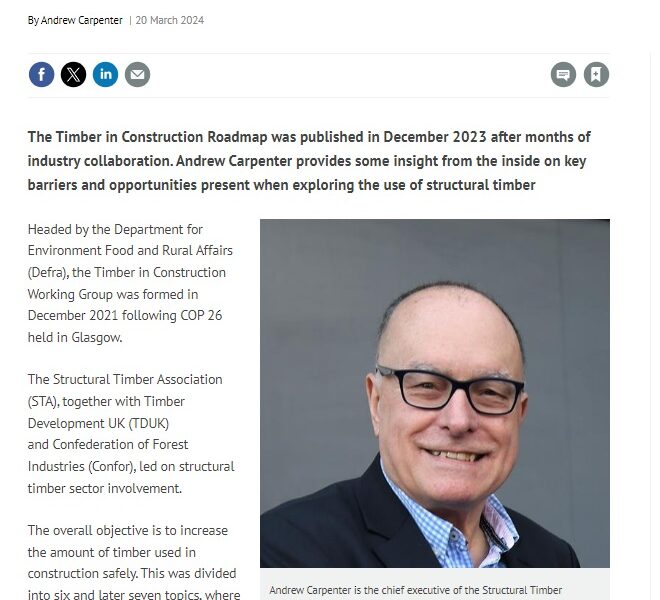What’s stopping the wider adoption of timber in construction?
20/03/2024

The Timber in Construction Policy Roadmap was published in December 2023, following many months of close collaboration within the industry. But how was the document put together from the early to late stages, and what are the key barriers to increasing the use of structural timber in construction and what opportunities does this present? Andrew Carpenter, Chief Executive of the STA spoke to BD Online, to look more closely at the Roadmap and provide some insight from the inside.
The Timber in Construction Working Group, headed by DEFRA, was put together in December 2021 following COP 26 held in Glasgow the month before. The STA was involved from its inception and, together with Timber Development UK (TDUK) and Confederation of Forest Industries (Confor), has led on structural timber sector involvement. The overall objective to safely increase the amount of timber used in construction was divided into first six and later seven topics, where barriers and opportunities were interrogated and recommendations to overcome them created for both government and industry. The priority themes are demand, supply, carbon, building safety, insurance, skills and innovation. Each topic had a separate working group made up of industry experts.
Between the STA, TDUK & Confor, we utilised the expertise and experience available to curate a report on the industry back in December 2022, and much of this report was used within the roadmap and essentially drove the data side of the document. It was crucial that we had accurate data in terms of market share and carbon impact, and we wanted to demonstrate just how much of a positive impact the increased use of timber in construction would have.
As has already been mentioned, a big part of the process was identifying the main barriers that prevent the wider adoption of structural timber. A key driver from DEFRA was the use of more home-grown timber, but the barrier for this is considerably more long term. While this isn’t something that can be achieved immediately, the STA are working closely with Confor to support this achievement in the long term.
In the shorter term, the key is to help new adopters of structural timber systems make the transition from more traditional methods. However, there is still a myth that timber is not as cost effective as other materials, which presents another considerable barrier. However, we are now developing a new cost comparison tool that covers a range of sectors to offer transparency.
Another issue we are able to tackle now is around skills and training, which was highlighted as a key challenge within the roadmap. This one is quite apt from an STA point of view, as a series of new training schemes is set to be announced in the coming weeks, covering all levels of the build process from design to construction. Ultimately, the industry will benefit from upskilling all parties, from architects to erectors and installers, and the STA are taking the responsibility to drive the solution in this area.
What is key now for the future of the industry and for driving practical results from the guidance and insight of the roadmap is to agree KPI’s, measuring them, and of course, achieving them. The is now on turning plans into actions without delay in order to achieve the objectives of the roadmap and increase the use of structural timber in construction.
Read the full article here.